Summer has finally arrived, bringing warmer temperatures and much needed sunshine. Like most people, as soon as the temperatures rise, most of our spare time is spent in our gardens. But, in the rush to get that BBQ started, don’t forget that summer also brings its own brand of particular troubles for your gardens plant life.
Unfortunately tree disease can devastate your garden at any point throughout the year, and whilst keeping up with regular maintenance can mitigate the effect of disease and pests on your woody plants, extra attention needs to be paid toward spotting the signs of seasonal specific tree diseases.
The following article gives an overview of some of the most prevalent summer tree diseases and the signs and symptoms you can use to spot them.
Honey Fungus
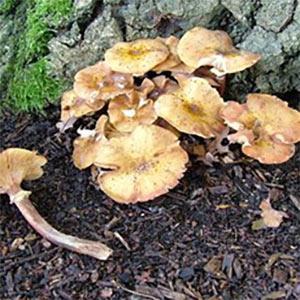
The colloquial name given to a group of several different species of fungi, Honey Fungus attacks and kills the roots of many woody and herbaceous perennials. One of the most destructive fungal diseases affecting UK gardens, Honey Fungus quickly spreads underground, causing the swift death and decay of the roots, and the rest of the tree.
You can spot an affected tree by the white coloured fungal growth (mycelium) between the bark and wood at the ground level, and the honey coloured toadstools from which the disease gets its name, although these only appear in the later summer months.
How to Spot Honey Fungus
- If you’ve noticed that the upper parts of your tree are dying for no apparent reason, specifically during periods of hot weather, this can indicate a failure in the root system caused by the fungus.
- The leaves will discolour, becoming paler and smaller, or will prematurely Autumn
- Cracking or bleeding of the bark at the base of the trunk
- The failure of the plant to flower, or a spate of unusually heavy flowering, or crop of fruit, which is likely just before the death of the plant
- Dead and decaying roots, with the characteristic sheet of white fungus between the bark and wood – most often detected at the collar region – which can be sometimes detected from a strong smell of mushrooms.
Chalara Dieback of Ash
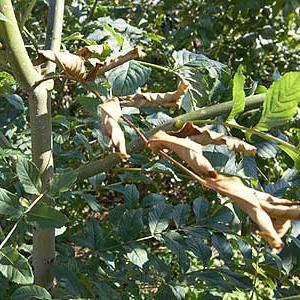
Ash dieback is one of the most damaging diseases on the list. First discovered in the UK in 2012, Ash dieback is spread through spores, which when dispersed by the wind, can reach over tens of kilometres, rendering it highly dangerous because of its contagious properties. When considering that there are over 12 million ash trees in parklands, gardens and hedgerows, as well as the 130,000 acres of ash woodland in the UK alone, the threat of this disease is very serious.
Whilst your trees are at risk of ash dieback all year round, it is in the summer when symptoms, such as small white fruiting bodies, become most noticeable.
Unfortunately, Ash dieback is incurable and although older and larger trees can survive with it for some time, there is no way to reverse the symptoms, or the onset of the disease. So if you do spot any of the following symptoms, be sure to talk to a professional arborist for advice on how to proceed.
How to Spot Ash Dieback
- Lesions, dark in color and often long, thin and diamond shaped, will appear at the base of the trunk
- The tips of shoots, as well as the leaves, will become black and shrivelled
- The veins in the leaves will begin to turn brown
- The tops of saplings die
Dutch Elm Disease
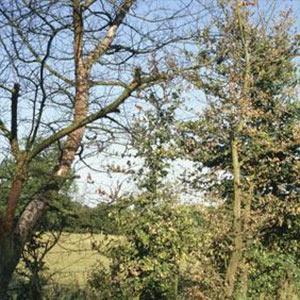
Dutch elm disease is actually believed to have originated in Asia, but it’s name comes from when it was first identified in the Netherlands back in the 1920’s.
Unfortunately, much like ash dieback, there is no current cure for the disease, as such it is imperative that all new cases are reported so the disease can be tracked, as the disease has the potential to ravage the British landscape. In just two outbreaks, an estimated 25 million British elm trees were killed.
Whilst spread by elm bark beetles, the disease is actually fungal, and once infected, blocks the water transport system.
The symptoms often appear in early summer, so be sure to keep an eye out from June onwards.
How to Spot Dutch Elm Disease
- The leaves will turn yellow and wilt, then brown and fall
- Shoots that are affected will deaden at the tips
- Twigs will become warped and develop dark streaks in the outer wood, or rings at cross sections
Dothistroma Needle Blight
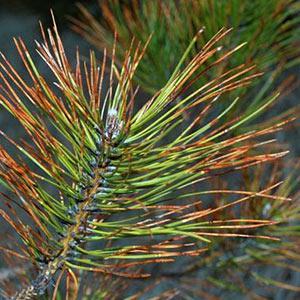
Otherwise known as red band needle blight due to the often colourful symptoms it can show, Dothistroma needle blight causes premature defoliation in conifers and a loss of yield that in severe cases, can lead to the death of the tree.
Since taking roots in Europe in the 1990s, the blight is no longer confined to the Corsican pine, and can also affect the only native British pine tree, the Scots pine.
Symptoms are most typically apparent between June and July.
How to Spot Dothistroma Needle Blight
- Needles develop yellow and tan coloured spots and bands, which later turn red
- Infected needles shed rapidly, quite often leaving only a tuft of current needles at the ends of branches
Oak Processionary Moth
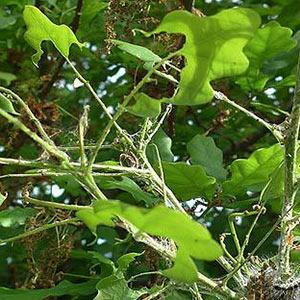
Whilst the oak processionary moth is more notable for its impact on human health – the hairs of the moth and caterpillar contain a toxin which at best causes mild irritation, at worst, induces asthma – the moth and their larvae can greatly weaken trees, making them more susceptible to catching other infections.
Centered almost exclusively in the London and Berkshire area, their population has steadily been growing, despite attempts to mitigate their growth.
Whilst the adult moth is relatively indistinct, being brown and similar in appearance to other species, the caterpillars are much easier to spot. The moths are active from mid to late summer, and target oak trees.
How to Spot the Oak Processionary Moth
- The caterpillars can be spotted around late spring and early summer in distinctive nose to tail processions, and also by their characteristic white, webbed nests over, only, the trunks and branches of oak trees
- In early summer you may notice white trails across the trunks and branches
Author bio:
Paul George is the managing director of Landmark Trading Ltd, and has worked in the arboricultural industry for 14 years. Landmark Trading are one of the the UK’s leading suppliers of arborist equipment. You can connect with Paul on Twitter, Facebook, Google + or call Landmark Trading on 01780 482231.
